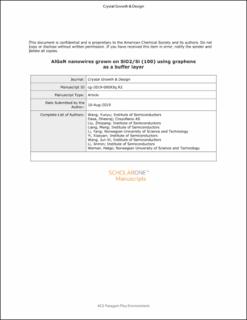| dc.contributor.author | Wang, Yunyu | |
| dc.contributor.author | Dheeraj, Dasa | |
| dc.contributor.author | Liu, Zhiqiang | |
| dc.contributor.author | Liang, Meng | |
| dc.contributor.author | Li, Yang | |
| dc.contributor.author | Yi, Xiaoyan | |
| dc.contributor.author | Wang, Junxi | |
| dc.contributor.author | Li, Jinmin | |
| dc.contributor.author | Weman, Helge | |
| dc.date.accessioned | 2020-04-07T11:04:02Z | |
| dc.date.available | 2020-04-07T11:04:02Z | |
| dc.date.created | 2019-09-29T13:56:36Z | |
| dc.date.issued | 2019 | |
| dc.identifier.citation | Crystal Growth & Design. 2019, 19 (10), 5516-5522. | en_US |
| dc.identifier.issn | 1528-7483 | |
| dc.identifier.uri | https://hdl.handle.net/11250/2650647 | |
| dc.description.abstract | III-Nitride epitaxy is deeply dependent on the substrate and is difficult to grow on amorphous substrates because of the lattice mismatch limits. In this paper, graphene is employed as a buffer layer to assist AlGaN nanowire growth on the SiO2/Si (100) substrate using the metal–organic vapor phase epitaxy (MOVPE) technique. The influence of growth parameters such as reactor pressure, NH3 flow, and substrate temperature on the morphology of nanowires has been studied. In particular, it has been observed that AlGaN nanowires with hexagonal morphology can be achieved under lower reactor pressure and lower NH3 flow, while the tip morphology can be modified with the substrate temperature during nanowire growth. The nanowires grown here are studied using scanning and transmission electron microscopy, photoluminescence, and cathodoluminescence to characterize the structural and optical properties and demonstrate the high quality of the grown nanowires. These findings provide a novel way to grow nanowires on any crystalline or amorphous substrate using graphene as a buffer layer, promising for future device applications. | en_US |
| dc.language.iso | eng | en_US |
| dc.publisher | American Chemical Society | en_US |
| dc.title | AlGaN Nanowires Grown on SiO2/Si (100) Using Graphene as a Buffer Layer | en_US |
| dc.type | Peer reviewed | en_US |
| dc.type | Journal article | en_US |
| dc.description.version | acceptedVersion | en_US |
| dc.source.pagenumber | 5516-5522 | en_US |
| dc.source.volume | 19 | en_US |
| dc.source.journal | Crystal Growth & Design | en_US |
| dc.source.issue | 10 | en_US |
| dc.identifier.doi | 10.1021/acs.cgd.9b00093 | |
| dc.identifier.cristin | 1730806 | |
| dc.relation.project | Norges forskningsråd: 259553 | en_US |
| dc.relation.project | Norges forskningsråd: 264206 | en_US |
| dc.description.localcode | Locked until 28.8.2020 due to copyright restrictions. This document is the Accepted Manuscript version of a Published Work that appeared in final form in [JournalTitle], copyright © American Chemical Society after peer review and technical editing by the publisher. To access the final edited and published work see https://doi.org/10.1021/acs.cgd.9b00093 | en_US |
| cristin.unitcode | 194,63,35,0 | |
| cristin.unitname | Institutt for elektroniske systemer | |
| cristin.ispublished | true | |
| cristin.fulltext | original | |
| cristin.qualitycode | 2 | |
